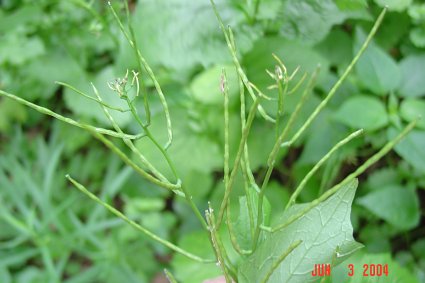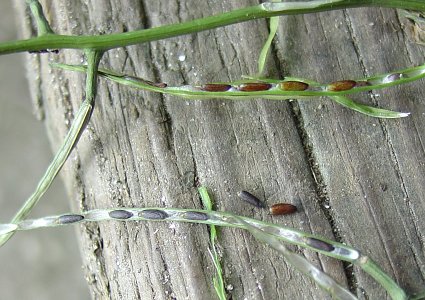

Quick Removal Tips
Identification
Look-Alikes
Biology
Notes of Interest
Garlic Mustard Recipe
GARLIC MUSTARD
Alliaria petiolata
Technique



Quick Removal Tips
Identification
Look-Alikes
Biology
Notes of Interest
Garlic Mustard Recipe
|
GARLIC MUSTARD
|

|

|
Before picking, notice surrounding leaves!
Poison ivy sometimes grows among garlic mustard plants. Children and first-time adults are most likely to recognize poison ivy after they get it, rather than on their first day out. Wear long sleeves to cover wrists. An extremely allergic person should not pick. |

|
A vigorous plant produces many long seed containers. Their structure is unique to the mustard family, and the pods are called siliques. |

|
Within the pods are a number of seeds. Ask a child to estimate how many seeds a plant produces. This makes a point - if a single plant is left behind, it is like planting over a hundred seeds. For this reason we are trying to remove EVERY plant. Search around trees, beyond logs, behind shrubs. It takes concentration, and chatting at the same time will lose a few plants! |

|
An exhausted puller left mature plants neatly piled under the crossing branches at this site a year ago. |

|
The result the following year, a zillion seedlings, confined to a small area, but still necessitating removal eventually. These plants are growing too densely for most to survive, so it makes sense to ignore them until their second year. |

|
A field of garlic mustard makes one wish someone had tended to the plants sooner. This area will probably take fifteen to twenty minutes. Garlic mustard has "taken off" when there are as many as five or six small plants per square foot. Removal is tedious. |

|
As seeds mature, lumps form in the pod. |
|
Seeds in different stages. Surprising as it sounds, seeds can mature even after the plant is picked. This is why we bag all garlic mustard. Contractor bags from a hardware store are larger and stronger than leaf bags, and definitely worth obtaining. Leaf bags also work, but hold less and develop holes more easily. Place bags near trash barrels for Park pick-up, 301-670-8080. 
|
|

|
Seeds in one pod are more advanced than the second. |
|
Fully mature seeds are black. They are shot as far as ten feet when the pod bursts.

|
|

|
The upper root tends to grow horizontally, and can be wavy. If a stem breaks at ground level, will the plant die? |

|
No, as shown here. Two dead stalks are surrounded by new growth. Until the "last minute," about June 15 or later depending on weather, plants can regenerate and flower. To prevent re-growth, search for and pull broken roots. Re-growth occurs only at the top of the root; a root broken half way down should not grow back. |

|
The best place to leave bags is at trash barrels. No phone call to request pickup is needed. Heavy bags can be grouped on the parkway if reported in time for early Monday pickup, 301-670-8080. |

|
Only "impossibly" heavy trash can be left on the walkpath where large trucks have no access. These bags must be reported so Park Maintenance knows to collect them. |

|
First-year growth of garlic mustard. The plant produces seed only in the second year, so effects of removal this year will show only in two years. As many plants might appear next year as this year. If an area was contaminated only once, the mustard population would tend to appear in waves in alternate years.
It is repeatedly said on websites that seeds are viable for five years, so for at least five years after "perfect" pick-ups, Sligo woods will need to be inspected for stray plants. |